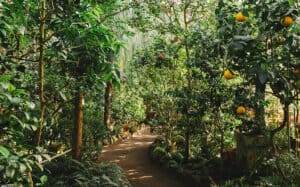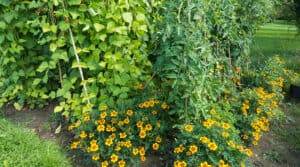Hugelkultur raised beds are one option when it comes to new growing areas. These can be an interesting and useful option to consider in a range of settings for growing annual crops.
In permaculture, we understand that choosing the right plants for where we live is often only part of the puzzle. There are a range of different strategies that we can use to create optimal growing conditions for our plants, and to increase the yields and the biodiversity of our gardens.
Hugelkultur draws on traditional practices to allow us to create raised beds with a number of benefits for plants, and for us. In this guide, we will introduce you to this concept, and its benefits, and help you successfully implement this idea where you live.
What are Hugelkultur Raised Beds?
Hugelkultur is a German word translated as ‘mound culture’. When we talk about Hugelkultur we are talking about a type of no dig garden, in which we create raised beds with layers of organic material over a core of decomposing woody material.
This idea shares a lot on common with other no dig gardening techniques, and is related to the concept of lasagna gardening. The difference between this and ordinary lasagna gardening, however, is that the bed contains larger woody pieces decomposing at the heart of the structure or in the base of a raised bed.
Traditionally, this type of raised bed would also have a mounded shape, rather than a horizontal top, though the idea has now evolved to also incorporate more typically shaped raised beds with woody cores.
The Origins of the Idea
The term was first used in a German-speaking gardening booklet in the 1960s. However, it describes practices that are a lot older. Farmers and gardeners in parts of Europe have been using rather similar techniques for centuries. The idea has also evolved at least in part from the biodynamic ideas of Rudolph Steiner and certain other natural gardening ideas.
A more traditional hugelkultur mound is around 1m in width and can be up to 4ft in height (more commonly around 2-3ft) at the center, creating a mounded shape with sides that slope down on both sides. Rotting logs are placed in a line down the center to form the skeleton or base of the structure.
Next, around the logs, a layer of leaves and sometimes turf (upside down) is placed. Then further layers of ‘brown’ carbon-rich, and ‘green’ nitrogen-rich materials are placed on top, before, once the desired height is reached, the mound is topped with a layer of compost and/or topsoil into which plants can be placed.
Adaptations to Traditional ‘Mound Culture’
Today, permaculture practitioners around the world have embraced this traditional mound technique. The idea has also been adapted to create raised beds in a range of different shapes and sizes, all of which share in common the idea of the rotting woody material within the structure.
Inspired by the original traditional long, straight mounds, permaculture practitioners have created woody core raised beds in curved, sinuous shapes, and in circular form.
Some also use the idea of having rotting wood within the structure, but rather than creating mounded shape beds, instead use the materials within a more typical flat-sided and flat-topped raised bed structure. These other beds share some, but not all, of the characteristics of a traditional hugelkultur mound.
The Benefits of Hugelkultur Raised Beds
The layering of materials above the ground in a hugelkultur system allow gardeners to create new growing areas without disrupting the precious, complex soil ecosystem below. This means that it is a core idea utilized in ‘no dig’ or ‘no till’ growing systems.
No dig gardening or no till farming aims to keep the soil as undisturbed as possible. When we disturb the soil, we disrupt the health of the soil web and the micro-organisms that maintain healthy plant growth. Soil structure can be damaged, and it can more easily be eroded or depleted of the nutrients it contains.
Like other no dig gardening techniques, hugelkultur raised beds allow us to build organic matter above the soil, creating fertile growing conditions with plenty of the soil organisms we need for successful yields.
In essence, what we are doing in a hugelkultur bed is composting in place. Rather than composting in a heap or bin, composting takes place within the structure itself.
As the woody logs and larger woody pieces within the core of the structure decompose, they become more porous and soak up water like a sponge. The water is retained more than it would be in other types of raised bed, and is then released slowly from the woody material, benefiting the plants growing within the structure.
As the woody material breaks down, it also creates air pockets within the structure, providing the aeration benefits of digging or tilling without the destruction of microbial life. The decomposing wood also increases the number of beneficial microorganisms within the growing area.
(One thing that it is important to note, however, is that as the wood breaks down, microbes take up nitrogen from the soil. This can mean that in the short term, nitrogen can be locked up, and therefore be depleted and less available to growing plants.
This is why it is important to balance ‘brown’ and woody materials with green nitrogen rich materials within the structure of the bed, to ensure that there is plenty of nitrogen within the system during this time.)
One other benefit of a traditional mound form is that the mounded shape allows growers to create diverse growing conditions within a relatively limited space (with drier conditions at the top of the mound, and moister conditions towards the base, and different sun and shade conditions for plants on different sides of the structure).
The growing area on the mounded surface is larger than the area that can be planted on a flat bed.
Where Hugelkultur Beds Are Used
Hugelkultur beds can be beneficial for many areas when used for annual production. However, it is important to note that they are not suitable for every site and application. So permaculture designers need to carefully consider where these should be used, and where other ideas will be better.
Hugelkultur beds can be beneficial for annual production. But since the beds will slowly lower and reduce in height over time as the woody material at the core breaks down, they are not the best option for trees, shrubs or other perennial planting that will remain in place over longer periods of time.
Hugelkultur beds are typically temporary structures that will last for 5-6 years or so, and typically not much longer unless they are rebuilt.
However, they can be beneficial in getting started where soils are shallow, infertile or compacted, and will help to improve the soil below. Once the woody material has broken down, it can be beneficial to continue adding mulch layers, and to transition to a lasagna gardening or sheet mulching technique.
Hugelkultur beds can be beneficial especially where growth in raised beds can be poor, due to a dry climate or a drying position. Since, as mentioned above, the structure of rotting woody material can help retain water within the growing area.
However, hugelkultur beds should not be used on slope for water retention. These structures of organic materials should not be confused with the more permanent swale and berm systems used slowing and increasing water infiltration on slope and they are not suitable for use in this way.
They are best used on a relatively level site, for annual polyculture crop cultivation.
How to Make a Hugelkultur Raised Bed
If you are interested in adopting this approach and making a hugelkultur raised bed for annual cultivation where you live, then the key things to consider up front are positioning, the shape and size of the bed, and, most crucially, the specific materials that you will use in its construction.
Positioning
The first thing to determine is where to place a hugelkultur raised bed. As mentioned above, these raised beds are best positioned on a relatively level site, where you wish to grow annual crops. Since most annual crops will require full sun, it is important not to place the bed in too shaded a location. A reasonably sheltered position is typically also best so that a range of annual crops can be grown.
Orientation is another important thing to consider. Remember, the shape of a mounded raised bed will create different growing conditions on different sides, depending on its orientation. On the southern side (in the northern hemisphere) there will be most sun, and slightly more shaded conditions will be available on the northern side of the structure.
Since hugelkultur mounds are best suited to annual cultivation, they will typically be a feature found within zone 1 of a permaculture design – relatively close to a home or centre of operation since they will be visited quite frequently.
Shape and Size
Remember, the hugelkultur method allows us to build long, straight mounds or flat-topped raised beds, or to create beds in a range of different curved or rounded shapes.
Permaculture practitioners will often use this method to maximise edge and biodiversity by creating beds in more organic and natural shapes and forms – inspired by the patterns and shapes found in the natural world. Organic forms allow us to think carefully about creating different growing conditions for different crops that will thrive in a particular location.
Whatever shape your raised beds take, access and practicality are key. Beds should usually be no more than 1-1.2m wide, so that you can easily reach the growing area from the sides.
Layering Materials
The most important thing to think about however, when creating hugelkultur raised beds is the specific materials you use to make them.
The Woody Core
It is best, where possible, to source woody material that has already begun to decompose. However, since this can be challenging to obtain (and doing so from natural systems may disturb them), we can use woody logs and branches pruned, pollarded or coppiced from the property, or close by in the surrounding area.
The larger the logs, the longer they will take to decompose, of course. And smaller woody pieces/ wood chips will break down more quickly. When I make hugelkultur mounds I like to use a combination of larger logs with smaller branches, twigs etc. between them.
You should source materials to make your new raised bed or beds from as close to home as possible. The ideal is to use whatever materials are available to you on your own property.
Still, you should note that some trees will break down much more quickly than others (and some take a very long time and will lead more nitrogen to be locked up as they do so). Cedar and some other conifers might not always be the best choice, for example.
It is also worth thinking carefully before using wet woods that might regrow. Ands note that some woods can potentially have allelopathic effect on the crops you wish to grow.
However, these might still be used with certain caveats if abundantly available.
Always think about the properties of woods that you might have available before using them in this way. They might better be used for other things. But always use what you have available rather than importing materials from elsewhere.
Organic Matter Layers
To reduce potential for nitrogen problems as the woody material breaks down, the next layer above/ around the woody material should be rich in nitrogen. Sometimes, grass turf is used if this has been removed from the site or from other areas of a garden.
Green, leafy material of different kinds – from grass clippings, to leaves of nitrogen-fixing plants, can also be used. And, if you have livestock, you might add a layer of well-rotted manure, or the material from a deep-litter-bed system.
Next, we layer on carbon-rich materials – such as autumn leaves, untreated cardboard, etc. to maintain balance within the system and the structure of the medium.
Typically, the next layer will be another layer relatively rich in nitrogen, but materials at a more advanced stage of decomposition. A part-finished compost is ideal.
As we build the bed, we will pack down each layer onto the one below.
Top Layer – Planting Substrate
Finally, the mound or raised bed is topped with a layer of finished compost/ leaf mold and top soil into which you can plant.
It is a great idea when planning a garden to think about where we can find synergy within the processes we undertake. For example, we can consider topping a hugelkultur raised bed with topsoil taken from an area where we have decided to create a pond, or another feature of this kind.
With the right approach, you can often make sure that creating new raised beds does not involve importing any external materials at all.
Planting Up a Hugelkultur Raised Bed
There is some difference of opinion about whether or not you should leave a Hugelkultur mound or raised bed to mature before planting, or plant up the structure right away.
In my opinion, it is best to plant up the new structure as soon as possible. This prevents any potential issues of erosion that can arise if you leave the top of the bed bare. It also reduces potential for nutrient runoff that could cause issues in the environment. And also reduces that chance of weeds colonising your new growing area too vigorously.
If you create your raised bed in autumn/ fall, it can be beneficial to add a winter cover crop if you cannot grow edible annuals right away where you live. If you create your bed at the beginning of your primary growing season then you can begin to grow your annual crops right away.
Using plug plants/ starts or plants sown from seed elsewhere and transplanted is the best option for this type of bed. Just make sure that you plant these at the right time for the crops you are growing and where you live.
You can use your new hugelkultur raised bed or beds to grow a huge range of annual crops and their companion plants. Just remember to think about the needs of the different plants you place, and the different growing conditions created by the shape and orientation of your beds when planning your plant layout.
With careful placement and construction, and the right layout and plant choices, hugelkultur raised beds can deliver abundant yields.







